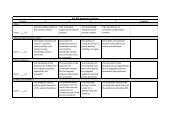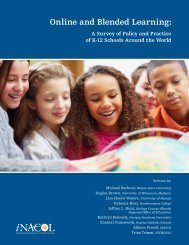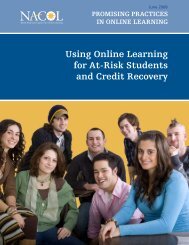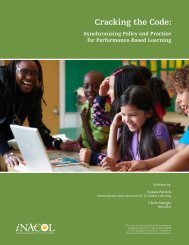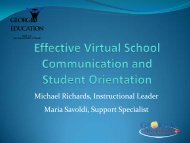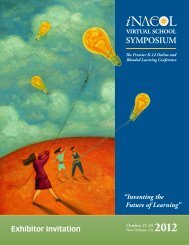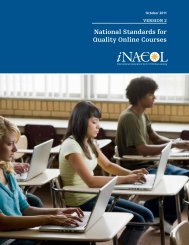An Exploration of At-Risk Learners and Online Education - iNACOL
An Exploration of At-Risk Learners and Online Education - iNACOL
An Exploration of At-Risk Learners and Online Education - iNACOL
You also want an ePaper? Increase the reach of your titles
YUMPU automatically turns print PDFs into web optimized ePapers that Google loves.
Trends <strong>and</strong> Instructional Practices for Teaching <strong>At</strong>-<strong>Risk</strong><br />
Students in K-12 <strong>Online</strong> Programs<br />
Battan <strong>and</strong> Russell (1995) stated that “there is no such thing as the ‘typical’ at-risk student, <strong>and</strong><br />
therefore there can be no ‘typical’ program or program components” (p. 90). Embracing a<br />
philosophy <strong>of</strong> using self-paced curriculum <strong>and</strong> individualized instruction has helped to reach<br />
students who have had limited success in traditional educational systems (Hurley, 2002). Key factors<br />
for improving at-risk student outcomes are: small class <strong>and</strong>/or school size, flexible approaches<br />
to timetabling <strong>and</strong> to learning needs, alternative programs that improve access <strong>and</strong> choice in<br />
the curriculum, individualized programs, recognition <strong>of</strong> the learner by allowing self-direction<br />
<strong>and</strong> ownership <strong>of</strong> the learning process, promotion <strong>of</strong> positive student/teacher relationships, <strong>and</strong><br />
accessible re-entry for students who wish to return to school (Dwyer, 1996; Maptone, 1999;<br />
Webber & Hayduk, 1995).<br />
Wheeler, Miller, Halff, Fern<strong>and</strong>ez, Gibson, <strong>and</strong> Meyer (1999) asserted that at-risk students have the<br />
potential to succeed if their needs are recognized <strong>and</strong> addressed. To be successful, both face-to-face<br />
<strong>and</strong> online learners need to be motivated <strong>and</strong> engaged in tasks <strong>and</strong> course participation. “While<br />
motivation tends to be an internally driven characteristic, it is also known that external factors such<br />
as the teacher, course design, <strong>and</strong> learning activities can <strong>and</strong> will influence motivation within the<br />
context <strong>of</strong> learning” (Aragon, Johnson, & Shaik, 2001, p. 14). In her study <strong>of</strong> cyber school students,<br />
Weiner (2003) found that motivation was one <strong>of</strong> the key factors in determining success in the K-12<br />
online learning environment.<br />
Roblyer (2006) indicated that it is not surprising that virtual programs that enroll a high percentage<br />
<strong>of</strong> at-risk students are much more likely to have high dropout <strong>and</strong> failure rates. Creating <strong>and</strong> using<br />
prediction models to identify at-risk virtual learners has assumed an increasing urgency in virtual<br />
schooling (Roblyer & Davis, 2008). In the absence <strong>of</strong> such models, this section explores some <strong>of</strong> the<br />
teaching practices, instructional strategies, <strong>and</strong> online design <strong>and</strong> delivery methods used with at-risk<br />
students.<br />
Methodology<br />
This section aims to identify specific teaching practices <strong>and</strong> instructional strategies, as well as online<br />
design <strong>and</strong> delivery methods used to assist at-risk students who participate in online courses from<br />
virtual providers. A survey was created to determine the types <strong>of</strong> programs <strong>and</strong> practices that<br />
virtual schools use to assist at-risk students to successfully complete online coursework. It was<br />
designed <strong>and</strong> administered to virtual schools internationally, <strong>and</strong> then analyzed to determine specific<br />
techniques being utilized out in the field to assist at-risk students to successfully complete online<br />
courses.<br />
In order to create a common underst<strong>and</strong>ing <strong>of</strong> the meaning behind “at-risk”, the authors <strong>of</strong> this<br />
section provided the following description to the survey participants:<br />
Students at risk for dropping out <strong>of</strong> school, those who may be retained until graduation through<br />
participation in virtual programs, include students with identified special needs, students in<br />
14<br />
International Association for K-12 <strong>Online</strong> Learning



